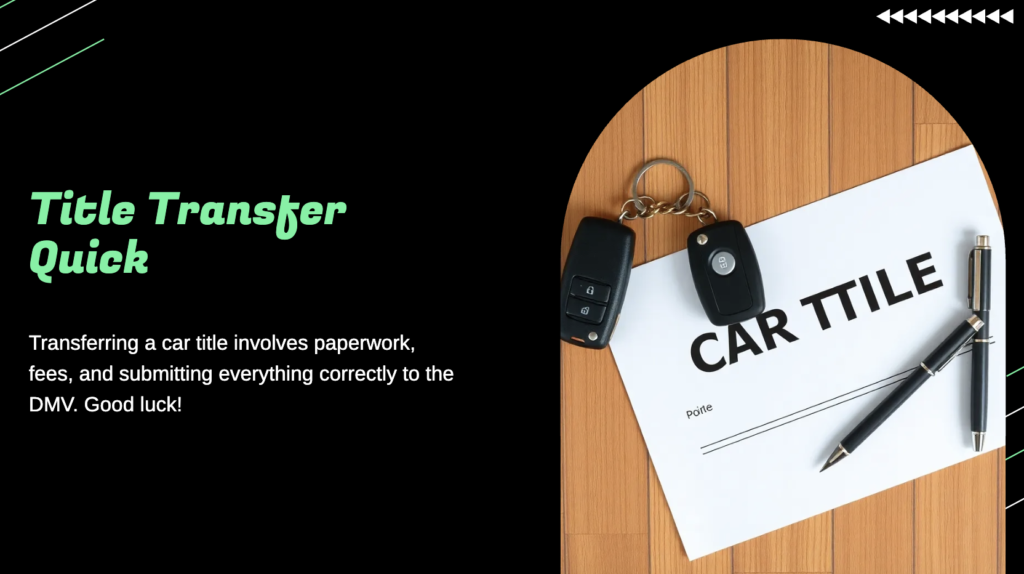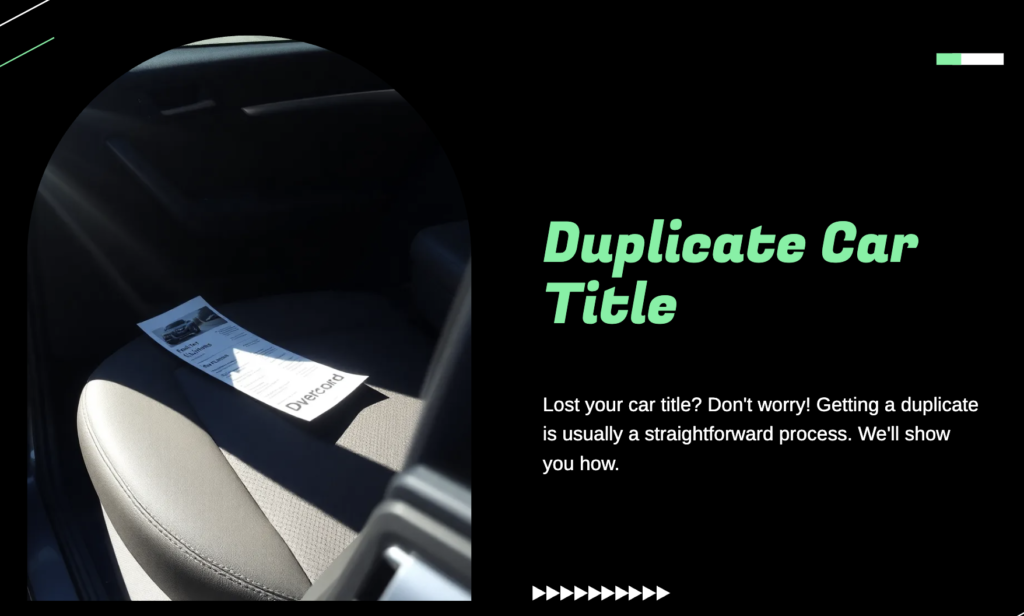Table of Contents
ToggleIntroduction to Auto Title Transfer

When you buy or sell a vehicle, transferring the title is an essential legal step that finalizes the change in ownership. This process ensures the new owner is officially recognized by the state as the vehicle’s legal owner. The requirements and procedures for an auto title transfer can vary depending on the state, but it generally involves completing the title with accurate information and submitting necessary documentation to the DMV.
Ensuring all details are correct and complete is critical to avoiding delays or complications in the process. The title serves as proof of ownership, and without it, the transfer cannot be completed, making it vital to have the document in hand before initiating the transfer. If the original title is missing or damaged, you’ll need to secure a replacement before proceeding.
The auto title transfer process also often requires clearing any liens on the vehicle, which means any outstanding debts tied to the car must be settled. In some states, additional forms such as a bill of sale or an odometer disclosure statement might also be required.
These documents help establish the transaction’s legitimacy and ensure transparency between the buyer and seller. Preparing ahead and understanding the necessary steps and requirements will help make the title transfer as straightforward as possible.
Understanding the Need for a Duplicate Car Title
A duplicate car title is essential when the original document is no longer available due to being misplaced, damaged, or stolen. Without a valid title, you cannot complete critical tasks like selling or transferring ownership of your vehicle.
Errors on the original title, such as incorrect details or incomplete information, can also necessitate obtaining a duplicate. In some cases, life events such as moving or organizing important paperwork may result in losing track of your title, making it necessary to secure a replacement.
Additionally, a duplicate title might be required in situations where multiple owners need to have their own copy of the document, particularly in the case of joint ownership or inherited vehicles. Applying for a duplicate ensures you can move forward with legal processes without unnecessary delays or complications. It is a proactive step that prevents future obstacles when dealing with your car’s ownership documentation.
Step-by-Step Guide to Auto Title Transfer
Successfully navigating the auto title transfer process requires attention to detail and adherence to state-specific requirements. Begin by gathering all the necessary documents, including the original title, a valid ID, and any additional forms required by your state, such as a bill of sale or odometer disclosure statement. Verify that the current title is free of liens, as any unpaid loans must be addressed before proceeding.
Next, complete the title by filling out all required sections with accurate and legible information. Both the buyer and the seller must provide their full names, addresses, and signatures, along with the date of sale and the purchase price. If there are any joint owners, their signatures may also be required. Be sure to write clearly and avoid crossing out or altering information, as this can lead to delays or the rejection of your application.
Some states may require the completion of an emissions or safety inspection before the transfer can be finalized. If applicable, ensure the inspection is completed and submit any related documents. Once everything is prepared, submit the completed title, any additional paperwork, and the applicable fees to your local DMV office or mail them if your state allows.
It’s helpful to retain copies of all documents submitted in case any issues arise during processing. Additionally, be prepared for possible waiting periods, as the processing time for an auto title transfer can vary depending on your state and the DMV’s workload. Remaining organized and informed throughout the process will help minimize potential setbacks.
How to Get a Duplicate Car Title

Applying for a duplicate car title is a necessary step when the original is missing, stolen, or damaged. To start, visit your state’s DMV website to download the duplicate title application form. Complete the form carefully, providing details like the Vehicle Identification Number (VIN), your name, and any other requested information. Be sure to use accurate and legible information to avoid processing delays.
You will also need to gather required documents such as a valid government-issued ID and, in some cases, proof of vehicle ownership like a registration or insurance card. Certain states may require additional verification, such as a lien release letter if applicable.
Once you have all the necessary materials, prepare to pay the duplicate title fee, which varies by state. Many DMVs allow you to submit your application and fee either in person, by mail, or in some cases, online, depending on the options available in your state.
In instances where the title was lost due to theft, some states might require you to provide a police report or a notarized statement explaining the circumstances. Once your application is submitted, the DMV will process your request and issue the duplicate title, either via mail or for pick-up at a local office. Keep track of the timeline for processing, as it can differ by state and method of submission.
Title Replacement: What to Do If You Lose Your Title
If your car title is lost, stolen, or damaged, you’ll need to apply for a replacement to maintain legal ownership of your vehicle. Start by checking your state’s DMV website for the appropriate title replacement application form.
Complete the form carefully, ensuring all information, such as your Vehicle Identification Number (VIN) and personal details, is accurate. Depending on your state, additional documents may be required, such as proof of identity or vehicle ownership, including a registration card or insurance document.
In some cases, a lien release letter might be necessary if there was a previous loan on the vehicle. Some states also request a notarized affidavit to confirm the title was lost or stolen. Be prepared to pay a replacement fee, which varies by location. Many DMVs offer multiple submission options, including in-person visits, mail, or online applications, so choose the method that best suits your needs.
If your title was stolen, some states might ask for a copy of a police report or additional documentation to verify the circumstances. Once your application is processed, the DMV will issue the replacement title, which will either be mailed to you or made available for pick-up at a local office. To avoid similar issues in the future, consider storing your new title in a safe, secure location where it is easy to access when needed.
Tips for a Smooth Auto Title Transfer
To ensure the auto title transfer process goes smoothly, begin by gathering all the necessary documents in advance. These may include the original title, a valid ID, and any additional paperwork required by your state, such as a bill of sale or an odometer disclosure statement. Carefully review your state’s specific requirements, as they can vary and may include inspections or notarized forms.
Complete all forms with accurate, legible information, and double-check for errors before submission. Ensure that all required parties, such as joint owners or lienholders, have provided their signatures if applicable. If the vehicle is subject to a lien, confirm that it has been released, and obtain a lien release letter if needed.
Consider reaching out to your local DMV for clarification on any unclear requirements or forms. This can help you avoid delays caused by missing or incorrect information. Pay attention to the applicable fees and have payment ready in the accepted format. Retain copies of all documents submitted for your personal records, as they can be helpful if you encounter any issues during processing.
Conclusion: Ensuring a Hassle-Free Vehicle Ownership Transfer
Taking the proper steps to manage your vehicle’s title is an important part of maintaining legal ownership and completing transactions like selling or transferring your car. Ensuring that all necessary documents are prepared, filled out accurately, and submitted on time is crucial to avoid delays or complications.
Whether you’re transferring ownership or replacing a lost or damaged title, being familiar with your state’s specific requirements and processes can make a significant difference.
For an auto title transfer, double-checking details such as signatures, lien releases, and additional forms ensures the process is completed without unnecessary issues. If you need a duplicate car title, gathering the required documents and submitting a complete application will allow you to obtain a replacement promptly.
Staying organized and retaining copies of all submitted paperwork will help address any unforeseen problems that may arise during processing.